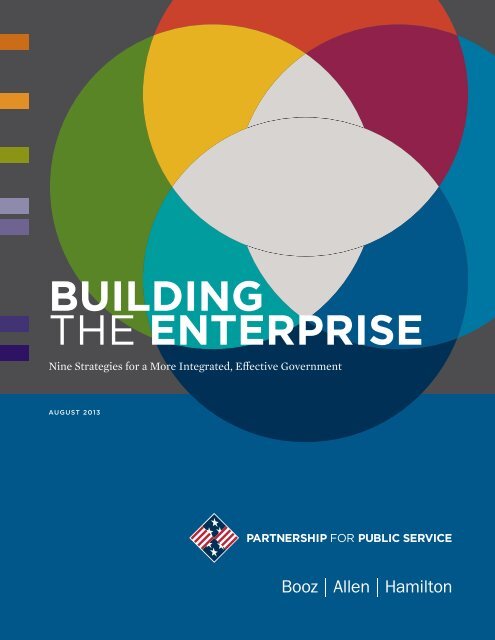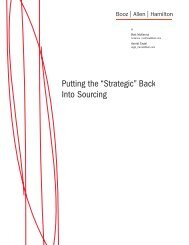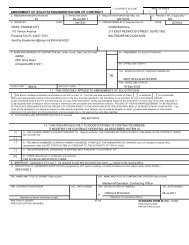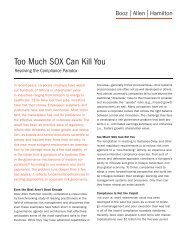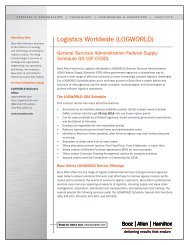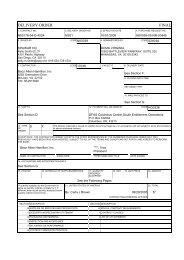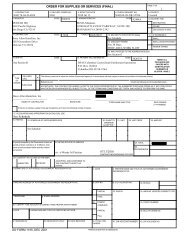Building the Enterprise - Booz Allen Hamilton
Building the Enterprise - Booz Allen Hamilton
Building the Enterprise - Booz Allen Hamilton
- No tags were found...
You also want an ePaper? Increase the reach of your titles
YUMPU automatically turns print PDFs into web optimized ePapers that Google loves.
BUILDING THETHE ENTERPRISENine Strategies for a More Integrated, Effective GovernmentAUGUST 2013BUILDING THE ENTERPRISEa
The Partnership for Public Service is a nonpartisan, nonprofit organization that works to revitalize <strong>the</strong> federal governmentby inspiring a new generation to serve and by transforming <strong>the</strong> way government works.<strong>Booz</strong> <strong>Allen</strong> <strong>Hamilton</strong> has been at <strong>the</strong> forefront of strategy and technology consulting for nearly a century. Today, <strong>Booz</strong><strong>Allen</strong> is a leading provider of management consulting, technology, and engineering services to <strong>the</strong> US government indefense, intelligence, and civil markets, and to major corporations, institutions, and not-for-profit organizations. In <strong>the</strong>commercial sector, <strong>the</strong> firm focuses on leveraging its existing expertise for clients in <strong>the</strong> financial services, healthcare,and energy markets, and to international clients in <strong>the</strong> Middle East. <strong>Booz</strong> <strong>Allen</strong> offers clients deep functional knowledgespanning consulting, mission operations, technology, and engineering—which it combines with specialized expertise inclients’ mission and domain areas to help solve <strong>the</strong>ir toughest problems.The firm’s management consulting heritage is <strong>the</strong> basis for its unique collaborative culture and operating model, enabling<strong>Booz</strong> <strong>Allen</strong> to anticipate needs and opportunities, rapidly deploy talent and resources, and deliver enduring results. Bycombining a consultant’s problem-solving orientation with deep technical knowledge and strong execution, <strong>Booz</strong> <strong>Allen</strong>helps clients achieve success in <strong>the</strong>ir most critical missions—as evidenced by <strong>the</strong> firm’s many client relationships thatspan decades. <strong>Booz</strong> <strong>Allen</strong> helps shape thinking and prepare for future developments in areas of national importance,including cybersecurity, homeland security, healthcare, and information technology.<strong>Booz</strong> <strong>Allen</strong> is headquartered in McLean, Virginia, employs more than 23,000 people, and had revenue of $5.76 billionfor <strong>the</strong> 12 months ended March 31, 2013. For over a decade, <strong>Booz</strong> <strong>Allen</strong>’s high standing as a business and an employerhas been recognized by dozens of organizations and publications, including Fortune, Working Mo<strong>the</strong>r, G.I. Jobs, andDiversityInc. More information is available at www.boozallen.com. (NYSE: BAH)bPARTNERSHIP FOR PUBLIC SERVICE | BOOZ ALLEN HAMILTON
PREFACEWhen we launched this project one year ago, ourgoal was to define and articulate a set of reformsthat would help guide <strong>the</strong> presidentialmanagement agenda. We started by interviewing someof <strong>the</strong> smartest public management experts we know—seasoned practitioners and policy makers who have conceivedand implemented government reforms, scholarswho have studied and documented reform efforts foryears, and executives who are driving management innovationin <strong>the</strong> public and private sectors.It was immediately obvious that <strong>the</strong> task was goingto be complicated. Many good ideas were tested during<strong>the</strong> past two decades by <strong>the</strong> Clinton and Bush administrations.The Obama administration abandoned some andadopted o<strong>the</strong>rs in whole or part, and in July 2013 recommittedto streng<strong>the</strong>ning three pillars of its managementagenda—improved service delivery, reducing waste andsaving money, and increasing <strong>the</strong> transparency of governmentdata.While our experts offered a wide range of differingproposals for improving government operations, consensusemerged around two basic <strong>the</strong>mes: one, that fiscal constraintsprovide both incentive and opportunity to findsmarter ways of doing <strong>the</strong> people’s business; two, that <strong>the</strong>problems our nation faces—from national security to <strong>the</strong>economy to health care—are growing increasingly complexand cannot be solved by any individual agency. Mostchallenges today require <strong>the</strong> collective action of severalagencies and, in many instances, <strong>the</strong> engagement of local,state and international partners in <strong>the</strong> public and privatesectors. The problem is that our government is not set upto easily achieve such unity of effort and often has multipleagencies and programs acting separately to achieve<strong>the</strong> same or similar outcomes—a hindrance for both <strong>the</strong>employees who must perform government missions andfunctions, as well as for those who depend on <strong>the</strong>m.So <strong>the</strong> recommendations in this report focus on acentral premise: Our government must take a more coordinated,multiagency, whole-of-government approach—in o<strong>the</strong>r words, an enterprise approach—to <strong>the</strong> nation’smost difficult and enduring challenges.In times of crisis, Americans are very good at rallyingaround a desired outcome once it has been clearlydefined. Defeat <strong>the</strong> Nazis. Make sure war-torn Japan andEurope survive as democratic societies. Win <strong>the</strong> race to<strong>the</strong> moon. Take care of <strong>the</strong> elderly. Clean <strong>the</strong> polluted airand water. Fight terrorism. Crises focus us and unify ourgovernment. Agencies collaborate and act as one. Government’sresources are marshaled and applied. But in <strong>the</strong>absence of obvious, pressing crises, this unity of purposeand action is <strong>the</strong> exception ra<strong>the</strong>r than <strong>the</strong> rule. Given<strong>the</strong> nature of <strong>the</strong> challenges that our government and nationface, that must change. Our bottom line is that governmentmust approach its work as an enterprise everyday to tackle today’s critical challenges. Spur economicgrowth. Reduce joblessness. Fix education. Safeguardfood. Halt nuclear proliferation. Secure cyberspace.By taking a multiagency enterprise approach to thosechallenges, we can build on <strong>the</strong> progress of <strong>the</strong> past twodecades, improve <strong>the</strong> overall performance of <strong>the</strong> federalgovernment and, in so doing, restore <strong>the</strong> American public’strust and confidence in it.The outcome we seek is a federal government thatacts as a single, integrated enterprise—not a set of disconnectedagencies and programs—in taking on its biggestproblems.Max StierPresident and CEOPartnership for Public ServiceLloyd W. Howell Jr.Executive Vice President<strong>Booz</strong> <strong>Allen</strong> <strong>Hamilton</strong>BUILDING THE ENTERPRISE 1
2 PARTNERSHIP FOR PUBLIC SERVICE | BOOZ ALLEN HAMILTON
THE CASE FOR ENTERPRISEWhen Superstorm Sandy wreaked havoc in <strong>the</strong>mid-Atlantic region during <strong>the</strong> fall of 2012, <strong>the</strong>Federal Emergency Management Agency coordinateda massive federal response, drawing life-savingsupport services from <strong>the</strong> Department of Defense (DOD),help for utilities from <strong>the</strong> Department of Energy (DOE),housing assistance from <strong>the</strong> Department of Housing andUrban Development (HUD), medical teams from <strong>the</strong>Department of Health and Human Services (HHS) andmuch more.The response to <strong>the</strong> destructive hurricane demonstratedhow government can and must act collectivelyduring a crisis and incorporated <strong>the</strong> lessons learned frommissteps seven years earlier during Hurricane Katrina.Perhaps <strong>the</strong> most important of those lessons was <strong>the</strong>need for a comprehensive management framework tounify federal, state, local and nongovernmental disasterresponse efforts. That framework was put in place, and itproved its worth in <strong>the</strong> aftermath of Sandy.But coming toge<strong>the</strong>r as an enterprise only duringa crisis is not sufficient. Increasingly, <strong>the</strong> problems ourgovernment faces require that same sort of collective actionday in and day out. In o<strong>the</strong>r words, <strong>the</strong> remarkableinteragency collaboration we saw during Sandy mustbecome <strong>the</strong> rule ra<strong>the</strong>r than <strong>the</strong> exception. However, ittakes more than just a declaration to that effect. As welearned in <strong>the</strong> aftermath of Katrina, it takes managementrules, procedures and leadership to enable federal agenciesto work in a more unified and coordinated manner.Historically, <strong>the</strong> federal government has been structuredwith each department and agency having its ownmission. Today’s challenges rarely fit into nice, neat bureaucraticboxes. By virtue of its very structure, <strong>the</strong> federalgovernment does not often act as a single enterprisebut typically performs just <strong>the</strong> way it is organized—asseparate, largely independent agencies that do not integrateand leverage <strong>the</strong>ir resources and expertise towarda common end.Examples of such fragmentation are numerous. TheGovernment Accountability Office’s (GAO) 2013 updateof government operations that are considered to be highrisk cited <strong>the</strong> 15 agencies that have overlapping responsibilityfor administering our nation’s food safety laws. 1All have different officials in charge, different chains ofcommand, different budgets and different overseers inboth <strong>the</strong> executive and legislative branches, despite <strong>the</strong>irshared, common mission. It is a testament to <strong>the</strong>ir commitmentto that mission that it is performed so well, butimagine how much more efficiently and effectively itcould be accomplished (and how much safer our foodsupply would be) if <strong>the</strong> efforts of those 15 agencies weremore integrated and unified.The GAO also reported that HUD, <strong>the</strong> Departmentsof Commerce and Agriculture, and <strong>the</strong> Small BusinessAdministration operate 53 different economic developmentprograms for businesses in poor and disadvantagedareas. Yet <strong>the</strong>se separate training, counseling, grantand loan programs seldom work in tandem to meet <strong>the</strong>needs of entrepreneurs or taxpayers. These departmentsand agencies are attuned to <strong>the</strong>ir own missions, budgets,programs and different congressional authorization andappropriations committees even though <strong>the</strong>y all have astake in a common goal. 2Overlap and redundancy are by no means limited to1 Government Accountability Office, High Risk Series, an Update, Feb.2013, 196–201.2 Government Accountability Office, 2012 Annual Report: Opportunitiesto Reduce Duplication, Overlap and Fragmentation, Achieve Savingsand Enhance Revenue, Feb. 2012, 52–61.BUILDING THE ENTERPRISE 3
cross-cutting mission areas. Theyalso occur with mission-supportfunctions, such as purchasing goodsand services and cutting payrollchecks. Suboptimal performance,duplication of effort, inefficiencyand wasted resources are <strong>the</strong> result.For example, agencies regularlypay too much for commodity purchasesbecause <strong>the</strong>y fail to leverage<strong>the</strong> combined buying power of <strong>the</strong>federal enterprise. Thus, while manyagencies, such as <strong>the</strong> Department ofCommerce, have consolidated IThardware and software purchaseswithin <strong>the</strong>ir own ranks to save millionsof dollars, this same approachapplied across government couldsave hundreds of millions of dollars.Needless duplication and overlapalso abound in <strong>the</strong> government’shandling of security clearance backgroundinvestigations to determinesuitability for federal hiring. Multipleagencies have made separateand costly investments in electroniccase management and adjudicationsystems for background investigationsinstead of working toge<strong>the</strong>r tocreate and use a shared system, accordingto <strong>the</strong> GAO. 3The president and <strong>the</strong> executivebranch must redouble <strong>the</strong>ir effortsto take a more holistic, enterpriseapproach to <strong>the</strong> multiagency missionsand functions of government.When we say that <strong>the</strong> federal governmentshould act more like an enterprise,we mean that it should betterintegrate and unify <strong>the</strong> efforts of<strong>the</strong> executive departments, agencies,bureaus and offices to achieve crosscuttinggoals, missions and functionsthat individual agencies cannot effectivelytackle on <strong>the</strong>ir own.While fully recognizing thatmany challenges require <strong>the</strong> participationof state, county and localgovernments as well as private organizationsand institutions and internationalpartners, we have chosen tolimit <strong>the</strong> boundaries of this report to3 Ibid. 79–83.“When we say that <strong>the</strong> federalgovernment should act morelike an enterprise, we meanthat it should better integrateand unify <strong>the</strong> efforts of <strong>the</strong>executive departments,agencies, bureaus and officesto achieve cross-cutting goals,missions and functions thatindividual agencies cannoteffectively tackle on <strong>the</strong>ir own.”focus specifically on <strong>the</strong> operation of<strong>the</strong> executive branch of <strong>the</strong> federalgovernment. However, <strong>the</strong> enterpriseapproach we advocate is justas necessary in tackling intergovernmentaland international challenges,and just as applicable.Taking <strong>the</strong> enterprise approachdoes not mean that government missionsand functions must be centralized.That approach has its ownset of bureaucratic problems. Norare we suggesting that current departmentaland agency missions beeliminated or that government bemassively reorganized. History hasshown that restructuring governmentis a politically charged, expensiveand time-consuming processthat often has unintended consequences.It typically fails to attack<strong>the</strong> root causes of a particular issueand, most importantly, diverts attentionfrom solving problems thatnow mutate faster than any reorganizationcan match. We need an approachthat is as adaptive and flexibleas <strong>the</strong> challenges it is designedto overcome.The enterprise model describedthroughout this roadmap meets thisobjective. Unlike past managementreforms, it minimizes <strong>the</strong> need forlegislation or wholesale restructuring.However, it does require morethan interagency committees, councilsand task forces—<strong>the</strong> traditionalapproach when agencies are forcedto work toge<strong>the</strong>r. It will require culturechange and commitment by seniorleaders, as well as investment inmanagement infrastructure.The president and <strong>the</strong> executivebranch can employ this new modelto address national public policygoals and cross-cutting federal missions,such as securing our nationand its borders, protecting our interestsabroad, ensuring food safety,sustaining economic growth and development,assuring a well-trainedand educated workforce, fosteringpublic health, facilitating internationaltrade and delivering social4 PARTNERSHIP FOR PUBLIC SERVICE | BOOZ ALLEN HAMILTON
services. Fur<strong>the</strong>r, applying an enterpriseapproach will increase savings,result in substantial efficiencies andimprove outcomes in cross-governmentaladministrative functionssuch as <strong>the</strong> management of finances,human capital, information technology,procurement and real property.For example, HUD and <strong>the</strong> Departmentof Veterans Affairs (VA)have collaborated successfully on agoal of ending homelessness amongveterans by 2015. Under <strong>the</strong> directionof <strong>the</strong> departmental secretaries,teams have coordinated <strong>the</strong> use ofHUD vouchers for veterans to rentprivately owned housing and targetedVA services such as health care,mental health and substance abusetreatment, vocational assistance, andjob development and placement. Aninteragency team of executives fromVA and HUD leads <strong>the</strong> effort in tandem,providing <strong>the</strong> two departmentswith weekly updates on voucher use,along with detailed reports on <strong>the</strong>status and recent activity of everyveteran in <strong>the</strong> program. Both departmentshave cooperated to ensurethat resources are being properlydeployed and goals are being met.The homelessness initiativecame about because of <strong>the</strong> personalcommitment of two Cabinet secretaries,who sent a strong signalthat <strong>the</strong> issue was important, madeclear <strong>the</strong>y wanted <strong>the</strong>ir staffs to collaborateand sustained <strong>the</strong>ir commitmentto dealing in an integratedway with multiple issues affectingveterans. The administration reportedthat <strong>the</strong> program has resulted ina 17.2 percent decline in veteranshomelessness from January 2009through January 2012, even in <strong>the</strong>face of difficult economic conditionsand a growing veterans population.We need to institutionalize thisapproach as a way of doing businessand make sure it is sustained and notdependent on <strong>the</strong> personality andgoodwill of Cabinet secretaries, whoafter several years may depart andleave cross-agency initiatives withouta champion.What we propose is not withoutprecedent or foundation. The seedsof an enterprise approach to governmentcan be found in <strong>the</strong> GovernmentPerformance and ResultsAct of 1993 (GPRA) and its progeny,<strong>the</strong> Government Performance andResults Modernization Act of 2010(GPRAMA). Toge<strong>the</strong>r, <strong>the</strong>se statutesprovide a basis for agencies to worktoge<strong>the</strong>r in a more coordinated andcross-cutting way.GPRA is a watershed law that for<strong>the</strong> first time required agencies to setconcrete performance goals, developstrategic plans to achieve thosegoals, measure <strong>the</strong>ir performance“We need an approach thatis as adaptive and flexibleas <strong>the</strong> challenges it isdesigned to overcome.”against <strong>the</strong>m, and report <strong>the</strong>ir progressto Congress. It also required <strong>the</strong>Office of Management and Budget(OMB) to craft a government-wideperformance plan to provide a perspectiveacross agencies. OMB didso, issuing plans in 1998 and 1999 aspart of <strong>the</strong> federal budget process,but <strong>the</strong> initiative was subsequentlyabandoned. As one government expertnoted, <strong>the</strong> government-wideplan was “a document in search ofan audience” because “no one feltownership” in <strong>the</strong> executive branchor in Congress.Times have changed. GPRAMAlaid <strong>the</strong> foundation for an enterpriseapproach to government byrequiring <strong>the</strong> White House to identifyand establish a small number ofhigh-priority cross-agency policyand management goals (see followingpage) and to name goal leadersto coordinate <strong>the</strong> activities of <strong>the</strong>multiple programs and agencies thatmust work toge<strong>the</strong>r to achieve commonobjectives.The good news is that agenciesand programs have set targets tomeet <strong>the</strong> overall cross-agency policygoals. These goals have includedenergy efficiency, job training andveterans’ career readiness, as well asmanagement initiatives such as reducingoverpayments and strategicsourcing. While progress has beenmade, initial outcomes have beenspotty. High-level administration attentionhas been missing, and absent<strong>the</strong> necessary infrastructure to operationalizeand sustain that attention,<strong>the</strong> stove-piped nature of governmenthas remained fully intact.The administration now has agreat opportunity. Without <strong>the</strong> needfor additional legislation, it can makeenterprise government a reality byexpanding and institutionalizing it,giving it teeth through strong seniorleadership engagement and commitment,and creating a managementinfrastructure.BUILDING THE ENTERPRISE 5
The Obama administration’s cross-agency priority goalsAs required by <strong>the</strong> Government Performance and Results Modernization Act of 2010 (GPRAMA), <strong>the</strong> Obama administrationestablished 14 cross-agency priority goals requiring collaboration across government. Nine deal with policy initiatives and fivecenter on administrative and management issues.ExportsDouble U.S exports by <strong>the</strong> end of 2014.Entrepreneurship and Small BusinessIncrease federal services to entrepreneursand small businesses with an emphasis onstart-ups, growing firms and small markets.BroadbandAs part of expanding all broadbandcapabilities, ensure 4G broadband coveragefor 98 percent of Americans by 2016.Energy EfficiencyReduce energy demand.Job TrainingEnsure our country has one of <strong>the</strong> mostskilled workforces in <strong>the</strong> world by preparingtwo million workers with skills trainingby 2015 and improving <strong>the</strong> coordinationand delivery of job training services.Veterans Career ReadinessImprove career readiness of veterans.By September 30, 2013, increase <strong>the</strong>percentage of eligible service memberswho will be served by career readinessand preparedness programs from 50to 90 percent in order to improve <strong>the</strong>ircompetitiveness in <strong>the</strong> job market.Science, Technology, Engineering,and Math (STEM) EducationIn support of <strong>the</strong> president’s goal that <strong>the</strong>U.S. have <strong>the</strong> highest proportion of collegegraduates in <strong>the</strong> world by 2020, <strong>the</strong> federalgovernment will work with educationpartners to improve <strong>the</strong> quality of STEMeducation at all levels to help increase <strong>the</strong>number of well-prepared graduates withSTEM degrees by one-third over <strong>the</strong> next 10years, resulting in an additional one milliongraduates with degrees in STEM subjects.Real PropertyThe federal government will manage realproperty effectively to generate $3 billionin cost savings by <strong>the</strong> end of 2012.CybersecurityExecutive branch departments andagencies will achieve 95 percentimplementation of <strong>the</strong> administration’spriority cybersecurity capabilities by <strong>the</strong>end of fiscal 2014. These capabilities includestrong au<strong>the</strong>ntication, trusted Internetconnections and continuous monitoring.SustainabilityThe federal government will reduce itsdirect greenhouse gas emissions by28 percent and will reduce its indirectgreenhouse gas emissions by 13 percentby 2020 from a 2008 baseline.Closing Skills GapsClose critical skills gaps in <strong>the</strong>federal workforce to improve missionperformance. By September 30, 2013,reduce by 50 percent <strong>the</strong> gaps forthree to five critical federal governmentoccupations or competencies, and closeadditional agency-specific high-riskoccupation and competency gaps.Improper PaymentsThe federal government will achievea payment accuracy rate of 97percent by <strong>the</strong> end of 2016.Strategic SourcingReduce <strong>the</strong> costs of acquiring commonproducts and services by agencies’ strategicsourcing of at least two new commoditiesor services in both 2013 and 2014 thatyield a savings of at least 10 percent.Data Center ConsolidationImprove information-technology servicedelivery, reduce waste and save $3 billionin taxpayer dollars by closing at least1,200 data centers by fiscal 2015.6 PARTNERSHIP FOR PUBLIC SERVICE | BOOZ ALLEN HAMILTON
BUILDING THE ENTERPRISE 7
ENTERPRISE STRATEGIES TOMAKE OUR GOVERNMENT MOREEFFICIENT AND EFFECTIVEAdopting an enterprise framework will allowour government to achieve <strong>the</strong> results that<strong>the</strong> American people demand and positionit to tackle <strong>the</strong> major challenges facing <strong>the</strong>nation. It also will enable government tobetter husband its resources and reduce programmaticfragmentation and overlap. To that end, we have identifiednine overarching strategies that will provide <strong>the</strong> infrastructureand impetus to take <strong>the</strong> enterprise approachto scale and ensure that it is not seen or treated as <strong>the</strong> petproject of one administration and thus become <strong>the</strong> firstvictim of <strong>the</strong> next.In proposing <strong>the</strong>se strategies, <strong>the</strong> Partnership forPublic Service and <strong>Booz</strong> <strong>Allen</strong> <strong>Hamilton</strong> consulted withmore than 50 current and former public officials, businessand labor leaders and academic experts to identifythose areas in most urgent need of reform. We built onmanagement initiatives of <strong>the</strong> current and past administrationsthat are working well and should be continuedand expanded. Our recommendations largely focus onwhat can be done by <strong>the</strong> executive branch without actionby Congress, although <strong>the</strong>re are legislative changesthat could improve <strong>the</strong> effectiveness of <strong>the</strong> enterprise approachand that will be needed to make improvements in<strong>the</strong> civil service.As one former federal leader bluntly stated, “No agencycan solve a complex problem by itself anymore. We’vemoved into a new era.” The Obama administration hastaken a first step toward enterprise government by establishinga limited number of interim cross-agency prioritygoals as directed by Congress under GPRAMA. The lawrequires <strong>the</strong> administration to update <strong>the</strong>se goals when itsubmits its 2015 federal budget. However, we believe <strong>the</strong>White House should extend <strong>the</strong> enterprise approach toa broader array of cross-agency goals, missions and administrativefunctions, and invest in <strong>the</strong> infrastructurenecessary to ensure that this approach becomes <strong>the</strong> acceptednorm.8 PARTNERSHIP FOR PUBLIC SERVICE | BOOZ ALLEN HAMILTON
STRATEGY 6Manage information technologyas a true enterprise resourceSTRATEGY 5Establish anindependent officeof evaluation toassess enterpriseperformanceSTRATEGY 2Build portfolios ofprograms alignedagainst <strong>the</strong> enterpriseplan’s goalsSTRATEGY 9Build anenterprise civilservice systemSTRATEGY 1Develop an enterprise performance planwith senior-level commitment to drivecross-agency goals and missionsSTRATEGY 7Take sharedservices toscaleSTRATEGY 4Develop careerenterprise executivesto lead cross-cuttingmissions and functionsSTRATEGY 3Designate andempower enterprisegoal leadersSTRATEGY 8Adopt an enterprise approach to <strong>the</strong>acquisition of goods and servicesBUILDING THE ENTERPRISE 9
STRATEGY 1DEVELOP AN ENTERPRISEPERFORMANCE PLAN WITHSENIOR-LEVEL COMMITMENTTO DRIVE CROSS-AGENCYGOALS AND MISSIONSNow that <strong>the</strong> administration has piloted<strong>the</strong> initial set of cross-agencypriority goals required by GPRAMA,it is time for <strong>the</strong> president to institutionalize<strong>the</strong> enterprise model andtake it to scale.We recommend that he start bydeveloping—and, more importantly,publicly committing to—a strategicenterprise performance plan. Thiscomprehensive, government-wideblueprint will identify <strong>the</strong> broadarray of missions and functions (including<strong>the</strong> top presidential priorities)that can best be achieved by <strong>the</strong>whole-of-government enterprise. Itwill set outcome- and time-basedgoals for enterprise missions andfunctions. As discussed in strategies2 and 3, it will put <strong>the</strong> necessaryinfrastructure and accountabilitymechanisms in place to increase <strong>the</strong>likelihood those targets are achieved.As noted earlier, this won’t be<strong>the</strong> first time a strategic enterpriseperformance plan has been attempted.The first attempt in 1998under GPRA got good marks fromGAO, but none<strong>the</strong>less failed in partbecause <strong>the</strong>re was no presidentialcommitment and no one was incharge of making sure <strong>the</strong> plan wasimplemented.The plan should be organizedaround enterprise goals to include<strong>the</strong> program and policy priorities of<strong>the</strong> president, such as reducing <strong>the</strong>unemployment rate of veterans. Italso should include enduring missionsand functions, such as assuring<strong>the</strong> safety of <strong>the</strong> nation’s food supply,that are no less important butthat have come to be expected by<strong>the</strong> American people and should notrequire presidential attention to ensuresuccess or necessarily changealong with administrations.Each enterprise goal shouldhave a balanced scorecard of quantitativeand qualitative performanceobjectives that commit <strong>the</strong> agenciesinvolved to tangible individual andenterprise outputs and outcomes.And each goal and set of performanceobjectives should be specific,measurable, assignable, realistic andtime limited. Here again, <strong>the</strong> administrationhas laid a solid foundationfor what we propose: It already posts<strong>the</strong> current GPRAMA cross-agencypolicy and management goals on <strong>the</strong>Performance.gov website.Many experts we consulted arguedthat <strong>the</strong> president’s budgetalready serves as <strong>the</strong> primary blueprintfor administration priorities,eliminating <strong>the</strong> need for a strategicenterprise performance plan. However,<strong>the</strong> budget is and always willbe organized by department andagency—in o<strong>the</strong>r words, accordingto <strong>the</strong> government’s stovepipes—anddoesn’t effectively communicatepresidential priorities to stakeholders.Agency-specific performanceplans won’t do <strong>the</strong> trick, ei<strong>the</strong>r,though <strong>the</strong>y have matured during<strong>the</strong> two decades since GPRA becamelaw. Nei<strong>the</strong>r addresses cross-agencymissions and functions and <strong>the</strong>reforecannot substitute for an enterpriseperformance plan focusing onmatters requiring collective agencyactivity, and clarifying each actor’srole in <strong>the</strong> achievement of <strong>the</strong> goals.This approach will begin to address<strong>the</strong> fragmentation, overlap and duplicationof federal programs and activitiesand, more importantly, serveas a blueprint for more effectivecross-agency collaboration on thosechallenges that are truly enterprisein nature.The strategic enterprise performanceplan must be owned by<strong>the</strong> president and <strong>the</strong> Cabinet, with<strong>the</strong> specifics of its development andimplementation a natural job for <strong>the</strong>President’s Management Council(PMC). And as a public expressionof commitment, <strong>the</strong> enterprise planshould be included in <strong>the</strong> president’sannual budget submission. In<strong>the</strong> budget, <strong>the</strong> enterprise performanceplan will orient <strong>the</strong> executivebranch, Congress and <strong>the</strong> public toan approach that better connectsagency and government-wide coststo enterprise results.The PMC, chaired by OMB’sdeputy director for management,comprises <strong>the</strong> chief operating officersof <strong>the</strong> executive departmentsand agencies (typically deputy secretariesand deputy administrators),plus <strong>the</strong> heads of central managementagencies, such as <strong>the</strong> Office ofPersonnel Management (OPM) and<strong>the</strong> General Services Administration(GSA). First established in <strong>the</strong>Clinton administration, <strong>the</strong> PMCtraditionally has served as a coordinatingbody, undertaking relativelyfew government-wide initiatives.It works with o<strong>the</strong>r councils,such as <strong>the</strong> Chief Financial OfficersCouncil and <strong>the</strong> Performance ImprovementCouncil, and oversees<strong>the</strong> President’s Management AdvisoryBoard, a group of private-sectorchief executive officers appointed by<strong>the</strong> president to recommend strategiesfor implementing best businesspractices in government.The time has come for <strong>the</strong> PMCto take more visible charge of <strong>the</strong> enterprise.It is ideally suited to develop<strong>the</strong> enterprise performance plan, supportedby staff, and to propose its goals,outcomes and timetables to <strong>the</strong> Cabinetand, ultimately, to <strong>the</strong> president,for ratification and endorsement.10 PARTNERSHIP FOR PUBLIC SERVICE | BOOZ ALLEN HAMILTON
“The strategic enterpriseperformance plan must beowned by <strong>the</strong> presidentand <strong>the</strong> Cabinet, with <strong>the</strong>specifics of its developmentand implementation a naturaljob for <strong>the</strong> President’sManagement Council.In addition, <strong>the</strong> PMC must playa central role in <strong>the</strong> plan’s execution.It must hold officials, includingsome in its own ranks, accountablefor turning <strong>the</strong> various componentsinto reality through regular and rigorousperformance reviews for eachcross-agency priority, mission andmanagement function. Today agenciescontributing to <strong>the</strong> president’scross-agency priority goals are primarilyfocused on <strong>the</strong>ir own programsand initiatives. The plan, with<strong>the</strong> PMC as <strong>the</strong> executing entity, canbring an enterprise focus.By taking this approach, <strong>the</strong>White House, <strong>the</strong> PMC and OMBwill send an unmistakable signalthat interagency collaboration onenterprise goals must become standardoperating procedure and thatagencies will be held accountablefor acting in <strong>the</strong> interests of <strong>the</strong> largerfederal enterprise. What’s neededis complete buy-in from top federalpolitical and career leadership, notjust a directive from <strong>the</strong> managementwing of OMB. •STRATEGY 2BUILD PORTFOLIOS OF PROGRAMSALIGNED AGAINST THEENTERPRISE PLAN’S GOALS”The PMC’s strategic enterprise performanceplan must align and integrateall of <strong>the</strong> programs that contributeto a particular goal, taking aportfolio approach to that alignment.Such an approach forces a holisticview of <strong>the</strong> goal’s constituent programsand <strong>the</strong>ir associated resources.Thus, <strong>the</strong> portfolio approach willunify <strong>the</strong> efforts of all <strong>the</strong> agenciesthat own those programs.This involves more than justinventorying <strong>the</strong> contributing programs,as is being done today wi<strong>the</strong>ach of <strong>the</strong> administration’s crossagencypriority goals. A portfolioapproach to each enterprise goalshould take those inventories to <strong>the</strong>next level, setting <strong>the</strong> stage for trueintegration. The relative resource investments,risks and results of eachof <strong>the</strong> various programs in a portfolioshould be considered and analyzedtoge<strong>the</strong>r, and compared in terms of<strong>the</strong>ir respective contribution to <strong>the</strong>enterprise goal and its qualitativeand quantitative outcome measures.Each portfolio should spell out <strong>the</strong>common responsibilities of <strong>the</strong>agencies and departments involvedand include <strong>the</strong> personnel and o<strong>the</strong>rresources needed to achieve <strong>the</strong> outcomesof <strong>the</strong> enterprise goal. Someprograms will be more costly thano<strong>the</strong>rs, but <strong>the</strong>ir individual resultsmay contribute more to <strong>the</strong> largergoal. O<strong>the</strong>r programs may be moreefficient, achieving better value for<strong>the</strong> dollar, but <strong>the</strong>ir impact on <strong>the</strong>larger goal may be far less apparent.The portfolio approach will illuminate<strong>the</strong> strengths and weaknessesof existing programs andidentify duplication as well as gaps.Portfolios of programs, not individualprograms, will become <strong>the</strong> organizationalapproach to collectivelyachieve enterprise results.The state of Maryland is usingthis approach to tackle <strong>the</strong> goalof reducing pollution in <strong>the</strong> ChesapeakeBay, an effort that involves responsibilitiesfrom multiple departments,agencies and programs. Thetasks, roles, accomplishments andshortcomings of each of <strong>the</strong> agenciesand programs are grouped toge<strong>the</strong>ron Maryland BayStat, a website thatprovides for <strong>the</strong> assessment, coordinationand reporting of <strong>the</strong> restorationeffort. Each month, <strong>the</strong> governorand <strong>the</strong> various departmentaland agency heads meet to assessprogress and chart <strong>the</strong>ir next steps.For a portfolio-based approachto be effective, <strong>the</strong> officials who arebeing held accountable for achievingenterprise goals must be able andwilling to independently assess <strong>the</strong>programs and resources available toBUILDING THE ENTERPRISE 11
“The portfolio approach willilluminate <strong>the</strong> strengthsand weaknesses of existingprograms and identifyduplication as well as gaps.achieve it, determine <strong>the</strong>ir effectiveness,and be empowered to recommendchanges to <strong>the</strong> PMC, OMB and<strong>the</strong> White House (see Strategy 3).Those leaders, in turn, must be willingto back <strong>the</strong> integration of programsand help in overcoming institutionaland jurisdictional barriersand o<strong>the</strong>r vested interests to fur<strong>the</strong>r<strong>the</strong> common mission objectives.Here’s an example of an enterprisegoal and its accompanyingprogram portfolio, drawn from <strong>the</strong>GAO’s March 2013 list of duplicativeand overlapping programs. Thegoal—reducing <strong>the</strong> scourge of illegaldrugs—is supported by a host offederal drug abuse prevention andtreatment programs fragmentedacross 15 federal agencies. Of <strong>the</strong> 76programs, 59 showed evidence ofoverlap. Even more telling is <strong>the</strong> lackSTRATEGY 3DESIGNATE AND EMPOWERENTERPRISE GOAL LEADERS”of integration and alignment. 4Drug prevention and treatmentare supposed to be coordinated by<strong>the</strong> Office of National Drug ControlPolicy (ONDCP) and could serve asa model of <strong>the</strong> enterprise approach.But <strong>the</strong> GAO observed that ONDCPhas not conducted a systematic assessmentof prevention and treatmentprograms to determine <strong>the</strong>extent to which <strong>the</strong>y overlap andwhere opportunities exist to pursuecoordination strategies to more efficientlyuse limited resources. Thus,while a portfolio-based approach isnecessary to executing <strong>the</strong> enterpriseperformance plan, it is not sufficient.It also takes leadership. •4 Government Accountability Office, Officeof National Drug Control Policy: Office CouldBetter Identify Opportunities to Increase ProgramCoordination, March 2013.Performance plans and portfoliosare important tools to define enterpriseobjectives, but it is strongleadership that will truly move <strong>the</strong>enterprise. Successful execution ofan enterprise performance plan dependson <strong>the</strong> designation of experiencedsenior officials to serve asenterprise goal leaders. As a formerCabinet member told us, “There area lot of great plans out <strong>the</strong>re, but ifyou don’t have <strong>the</strong> right people toimplement <strong>the</strong>m, <strong>the</strong>y’re not goingto get done.”Executive leadership is crucialand, with rare exception, it mustbe focused and full time. The administration’srecent effort to betterintegrate <strong>the</strong> various agencies overseeing<strong>the</strong> export of sensitive technologiesprovides an object lesson inthis regard. Despite an initial pushfrom several Cabinet secretaries andcommitment from <strong>the</strong> White House,<strong>the</strong> effort has floundered. Whileinitial steps were taken to improveoversight and streamline <strong>the</strong> interagencyprocess, <strong>the</strong> status quo remainsfirmly in place, and <strong>the</strong> systemis still plagued by poor coordinationand inefficiencies. The GAO concludedthat <strong>the</strong> agencies involveddid not work collectively in a unifiedway, and it faulted <strong>the</strong> Obamaadministration for not assigning responsibilityto one agency or leaderfor addressing <strong>the</strong> challenges of <strong>the</strong>entire portfolio of export controlprograms.<strong>Enterprise</strong> goal leaders musthave <strong>the</strong> skills and savvy—as wellas <strong>the</strong> gravitas—to lead multiagencyinitiatives or missions andcoordinate interagency teams. Ourrecommendation builds upon <strong>the</strong>current GPRAMA construct. Underthat framework, <strong>the</strong> president hasdesignated goal leaders for each of<strong>the</strong> cross-agency priority goals, andthose goal leaders are responsiblefor establishing governance councilsand reporting on progress. However,we would go fur<strong>the</strong>r, providinggoal leaders with sufficient bureaucraticmuscle over <strong>the</strong>ir programportfolios.Specifically, enterprise goalleaders must be expected and encouragedto take a holistic view of<strong>the</strong>ir portfolios, independently assess<strong>the</strong> portfolio’s constituent programsand provide hard-hitting,honest-broker recommendationsthrough <strong>the</strong> PMC to OMB and, insome cases, to <strong>the</strong> president onwhich programs should be contin-12 PARTNERSHIP FOR PUBLIC SERVICE | BOOZ ALLEN HAMILTON
cross-agency goal leaders have managedto make progress even though<strong>the</strong>y have o<strong>the</strong>r major responsibilitiesand no staff support. We can’tchange <strong>the</strong> fact that some enterprisegoal leaders will have o<strong>the</strong>r jobs, but<strong>the</strong>y can be allocated staff to overseeand coordinate <strong>the</strong> portfolio, includingsenior career executives to serveas <strong>the</strong>ir deputies. Without staff support,goal leaders will be at <strong>the</strong>mercy of <strong>the</strong> programs <strong>the</strong>y oversee.That said, we do not advocate <strong>the</strong>allocation of new staff resources tosupport goal leaders. Ra<strong>the</strong>r, staffwould be drawn from <strong>the</strong> managementof <strong>the</strong> portfolio’s constituentprograms.These levers notwithstanding,enterprise goal leaders still willneed to build consensus among <strong>the</strong>agency and program executives in<strong>the</strong>ir portfolios, as well as o<strong>the</strong>r keystakeholders, on common objectives,strategies, performance and outcomemetrics. HUD and DOE tookthat approach in 2009, agreeing onhow <strong>the</strong>y would jointly coordinate<strong>the</strong> use of stimulus funding to improveenergy efficiency of existinghomes. That agreement was documentedin a written memorandumof understanding signed by <strong>the</strong> twoCabinet secretaries, with each department’srole, responsibilitiesand obligations spelled out in detail.Agreeing on mutual expectations, aswell as setting ground rules for makingand enforcing decisions and resolvingdisputes, preempts conflictand makes interagency collaborationfar more likely. As one federalofficial said, it is critical to set up asystem to “communicate, coordinateand compromise.” •STRATEGY 4DEVELOP CAREER ENTERPRISEEXECUTIVES TO LEAD CROSS-CUTTING MISSIONS AND FUNCTIONSThe successful federal enterprisecannot depend on just Cabinet andsub-Cabinet appointees to lead it.To be sure, we expect that <strong>the</strong> presidentwill appoint his most trustedCabinet secretaries and sub-Cabinetofficials to lead presidential prioritiesincluded in <strong>the</strong> enterprise performanceplan. However, <strong>the</strong>re areonly so many of those appointees togo around. If <strong>the</strong> concept of enterpriseis ever to get to scale, career“Senior career executivesmust be developed with anenterprise perspective and<strong>the</strong> ability to demonstrate <strong>the</strong>enterprise leadership skills.”executives will have to be utilized.Some may be called upon to serveas <strong>the</strong> day-to-day deputies of Cabinet-levelgoal leaders, whose officialresponsibilities preclude full-timefocus. O<strong>the</strong>r career executives maybe asked to do even more, taking directcharge of cross-cutting missionareas and support functions.Are today’s career executivesup to it? <strong>Enterprise</strong> executives, withinteragency experience and government-widefocus, are exactly whathad been envisioned when <strong>the</strong> federalSenior Executive Service (SES)was created 35 years ago. However,that vision has never become a reality.With few exceptions, today’ssenior executives are agency-centricin experience and orientation, as organizationallystovepiped as <strong>the</strong> government<strong>the</strong>y serve. Most have remainedin <strong>the</strong> same agency for <strong>the</strong>irentire careers, promoted for <strong>the</strong>irtechnical skills and never movedacross or out of that organization tobroaden <strong>the</strong>ir experience or expertise.The result: Few are equipped tolead <strong>the</strong> enterprise.This must change if <strong>the</strong> conceptof enterprise is to succeed. Seniorcareer executives must be developedwith an enterprise perspectiveand <strong>the</strong> ability to demonstrate <strong>the</strong>enterprise leadership skills enumeratedearlier. This development mustbegin before senior executive statusis awarded. The intelligence agenciesoffer an example. Following <strong>the</strong>tragedy of 9/11 and revelations about<strong>the</strong> lack of communication among<strong>the</strong> intelligence agencies, <strong>the</strong> communitynow requires all executivecandidates to complete one or moreinteragency assignments of at least ayear in duration, as well as specifictraining in interagency leadershipbefore <strong>the</strong>y can be promoted to se-14 PARTNERSHIP FOR PUBLIC SERVICE | BOOZ ALLEN HAMILTON
“It’s very difficult to deal with<strong>the</strong> problems if you don’t knowwhich programs are workingwell and which ones are not.”nior ranks. In effect, <strong>the</strong> intelligenceagencies require a sixth enterpriseleadership Executive Core Qualification,in addition to <strong>the</strong> five nowmandated by OPM for promotioninto <strong>the</strong> SES.We believe OPM should makeinteragency or intergovernmentalexperience and enterprise leadershipcompetencies mandatory inorder to be selected for <strong>the</strong> SES.Doing so will take more than just apolicy declaration. This will requirean enabling infrastructure to brokerinteragency assignments. It alsowill require an enterprise executiveperformance appraisal system toensure consistent treatment of candidatesas <strong>the</strong>y move from agency toagency, a policy OPM has just institutedfor all of government. In addition,SES candidate developmentprograms need to be far more robustand far more enterprise-focusedthan today.Perhaps <strong>the</strong> most importantenabling mechanism would be <strong>the</strong>establishment of an <strong>Enterprise</strong> ExecutiveResources Board (EERB) todevelop and manage government’smost senior leadership talent. Todayevery agency has its own ExecutiveResources Board (ERB) chaired by asenior appointee such as <strong>the</strong> deputysecretary or equivalent, comprising<strong>the</strong> agency’s top political and careerexecutives and responsible for developingand selecting SES membersand assigning <strong>the</strong>m to key agencyleadership positions. Given <strong>the</strong>agency-centric focus of ERBs, it’s nowonder <strong>the</strong>re is no interagency executivemobility. The only enterpriseelement of <strong>the</strong> current senior executivedevelopment and selection processis an OPM qualifications reviewof all new SES members to ensure<strong>the</strong>y meet <strong>the</strong> five mandatory corequalifications.The executive resources boardmodel can be applied at <strong>the</strong> enterpriselevel. The White House shouldestablish an EERB chaired by OMB’sdeputy director for management,comprising PMC members, OPM’sdirector and some of government’smost respected former career executives.Their job would be to identify,evaluate and assign a select numberof career SES members for enterpriseposts, such as deputies to Cabinet-or sub-Cabinet-level enterprisegoal leaders, or goal leaders in <strong>the</strong>irown right. Not every SES memberwould qualify—<strong>the</strong> elite pool managedby <strong>the</strong> EERB would be limitedto those with interagency experienceand demonstrated enterpriseleadership skills. Those in <strong>the</strong> poolwould compete for prestigious enterpriseleadership positions.<strong>Enterprise</strong> executives drawnfrom career SES ranks, as well asthose selected from outside government,would serve five-year-termpresidential appointments, be compensatedat critical pay levels andhave performance contracts with<strong>the</strong> PMC. At <strong>the</strong> conclusion of <strong>the</strong>irterms, enterprise executives withcareer SES status could remain in<strong>the</strong>ir current enterprise executivepositions, be assigned to o<strong>the</strong>r suchpositions or return to career SES positionsin <strong>the</strong>ir home agencies. Allof <strong>the</strong>se actions would be overseenby <strong>the</strong> EERB, but administered byOPM executive resources staff. TheEERB also would monitor <strong>the</strong> benchof enterprise-qualified senior executivesand even aspiring SES candidates(GS-14s and -15s) to ensurethat <strong>the</strong>re is an adequate pipeline oftalent to fill enterprise positions as<strong>the</strong>y turn over. •STRATEGY 5ESTABLISH AN INDEPENDENTOFFICE OF EVALUATION TO ASSESSENTERPRISE PERFORMANCEGoal leaders and enterprise executivesmust be able to rigorously evaluate<strong>the</strong>ir portfolios of programs,determining which ones are workingand which are not. However, twodecades after <strong>the</strong> advent of GPRA,<strong>the</strong> federal government is strugglingto measure program performance.Government programs and governmentofficials tend to focus on <strong>the</strong>budget or <strong>the</strong> numbers of peopleserved, but <strong>the</strong>y are much less likelyto try to link those measures to realworldoutcomes.BUILDING THE ENTERPRISE 15
For example, it is easy to documenthow much money is budgetedfor a particular job training program,how many training classes that moneybuys, <strong>the</strong> number of people whoapply for and complete classes andeven <strong>the</strong> number who get jobs. However,it is difficult to determine causeand effect, that is whe<strong>the</strong>r traineesgot jobs as a result of <strong>the</strong> program.We recommend <strong>the</strong> establishmentof an Office of Evaluation, independentof agencies, within <strong>the</strong>Executive Office of <strong>the</strong> President orOMB, to conduct rigorous performanceassessments that will determineif programs are meeting <strong>the</strong>irgoals. This information will assistenterprise goal leaders, <strong>the</strong> PMCand OMB in making judgments onprogram effectiveness and on waysto make improvements. As one governmentofficial observed, “Whathas struck me is how few programevaluations are really done. Thereare 47 employment training programsand only four have had anyevaluations. There are some 18 foodand nutrition programs and onlythree of <strong>the</strong>m have had any substantiveevaluations. It’s very difficult todeal with <strong>the</strong> problems if you don’tknow which programs are workingwell and which ones are not.”The evaluation office should bepositioned, staffed and funded totake full advantage of today’s revolutionof big data, with access to <strong>the</strong>government’s vast data resourcesand an analytic staff of <strong>the</strong> best andbrightest evaluators.The office must be positionedto evaluate <strong>the</strong> portfolios of relatedprograms, ra<strong>the</strong>r than just one ortwo in isolation, and make judgmentson how <strong>the</strong>y contribute collectivelyand separately to a particularoutcome to provide goal leaderswith informed assessments.Since evaluation of governmentprograms can easily become ensnaredin politics, <strong>the</strong> office must beled by a respected career executiveon a seven-year term and administrativelyfirewalled from outsideinfluence. Only <strong>the</strong>n can it help goalleaders make hard calls.In keeping with objectives oftransparency and public accountability,<strong>the</strong> office should provideaccess to full performance data onportfolios and <strong>the</strong>ir programs on<strong>the</strong> Performance.gov website, unlessclassified or containing personallyidentifiable information. The missionof <strong>the</strong> assessment office won’tbe easy. One interviewee noted thatassessing and measuring whe<strong>the</strong>rprograms are producing results willtake “relentless, sometimes evenruthless, follow-through.”To get <strong>the</strong> attention of departmentand agency officials accountablefor programs, <strong>the</strong> evaluationoffice should issue program scorecardsto make <strong>the</strong> results of <strong>the</strong>evaluations clear and impactful. TheGeorge W. Bush administration useda scorecard to measure agency progressand effectiveness in each of itsfive management reform areas. Oneinterviewee noted that PresidentBush regularly asked Cabinet membersabout <strong>the</strong>ir red, green or yellowstatus on <strong>the</strong> scorecard. “I don’tknow how much he knew aboutit, or how much <strong>the</strong> Cabinet headsknew about it, but <strong>the</strong>y knew <strong>the</strong>ydidn’t want to be red or yellow. It gotpeople’s attention.” The system usedeasily understood stoplight ratings—green for success, yellow for mixedresults and red for unsatisfactory. •The five strategies recommended so far focus on improving<strong>the</strong> effectiveness of departments and agencies as<strong>the</strong>y confront today’s cross-cutting mission challenges.The enterprise approach also will produce order-of-magnitudeimprovements in efficiency by compelling agenciesto integrate across <strong>the</strong> resource base of <strong>the</strong> governmentas a whole. By treating commonly purchasedgoods and services as elements of a federal commons,ra<strong>the</strong>r than agency property, <strong>the</strong> enterprise approachwill accelerate nascent efforts to reduce duplication. Theenterprise will leverage economies of scale and provideor procure better, cheaper common goods and servicesranging from email and data storage to personnel andpayroll support, and almost everything in between. Theapproach also will rebuild <strong>the</strong> civil service as a more cohesiveand agile corps. The following are strategies to accomplish<strong>the</strong>se goals.16 PARTNERSHIP FOR PUBLIC SERVICE | BOOZ ALLEN HAMILTON
STRATEGY 6MANAGE INFORMATION TECHNOLOGYAS A TRUE ENTERPRISE RESOURCEInformation technology services areamong <strong>the</strong> most common services ingovernment. Every agency providesa range of <strong>the</strong>m, from email and datastorage to desktop support and serverfarms. Most recently, agencieshave begun deploying cloud-basedapplications to support everythingfrom time-keeping to supply-chainmanagement. With few exceptions,<strong>the</strong>se services follow <strong>the</strong> traditionalstovepiped model of government,with each agency approaching andduplicating <strong>the</strong>m separately. Thissituation represents a perfect opportunityto achieve real efficienciesby taking an interagency, enterpriseapproach to common IT services.Today <strong>the</strong> government spendsroughly $80 billion annually on IT—$55 billion of it on operating andmaintaining existing systems, <strong>the</strong>rest on buying and developing systems.Duplication is rampant andopportunities for enterprise savingsare huge.The Obama administration hasdirected all federal chief informationofficers to take a shared approachto providing IT resources. The CIOCouncil’s Federal Information TechnologyShared Service Strategy, issuedMay 2, 2012, directs agencies to“move from independent silos of capability(some of which are duplicative)toward an integrated matrix ofshared services that provide IT capabilitiesacross <strong>the</strong> entire agency.” 7The administration also has directedagency chief operating officersto lead annual IT portfolio reviews,known as “PortfolioStats,” to shoreup or end those that are performing7 Executive Office of <strong>the</strong> President, FederalInformation Technology Shared ServicesStrategy (Washington, DC, May 2, 2012);http://whitehouse.gov/sites/default/files/omb/assets/egov_docs/shared_services_strategy.pdf. Last accessed Jul. 26, 2013.poorly and eliminate those that areduplicative or not well aligned withagency missions or business functions.The process was designed toachieve a savings of 10 percent in ITcosts for each agency, 5 percent ofwhich could be given back to agenciesto reinvest in citizen-facing,cybersecurity or employee engagementprojects, according to FederalCIO Steven VanRoekel.The administration’s sharedservices strategy directs agenciesto begin by consolidating commodityIT services such as help desks,email, print and website management,online collaboration and mobile/wirelessservices, and providing<strong>the</strong>m as shared services withinagencies. Then, agencies are to expand<strong>the</strong> shared-first approach fromcommodity IT to mission-supportIT used in government-wide functions,such as financial and recordsmanagement. When a business case,including a cost comparison, showsit makes sense to outsource to across-agency IT shared service provider,agencies are expected to do sora<strong>the</strong>r than standing up or continuingagency-specific systems.This plan for cross-agencyshared IT services is a move in <strong>the</strong>right direction, but it needs to bemore aggressively pursued. Thefocus on enhancing IT capabilityshould be expanded into a portfolioapproach to all IT resources across<strong>the</strong> federal enterprise, not just withinagencies.We recommend that <strong>the</strong> federalchief information officer and <strong>the</strong>CIO Council give more power andcohesion to <strong>the</strong>se cross-agency effortsby leading <strong>the</strong> developmentand execution of a true enterpriseinformation technology strategy asan initiative under <strong>the</strong> enterpriseperformance plan described in Strategy1. This strategy should bundleIT shared services into portfolios(for example, an email portfolio or acloud portfolio) and designate goalleaders to maximize each portfolio’senterprise value, functionality, efficiencyand effectiveness.This does not necessarily requirea monolithic approach. But itdoes mean that IT, including physicalassets such as data centers andserver farms, will be consideredenterprise or whole-government assets,not <strong>the</strong> property of individual“This [administration’s] planfor cross-agency shared ITservices is a move in <strong>the</strong> rightdirection, but it needs to bemore aggressively pursued.”BUILDING THE ENTERPRISE 17
agencies. Such enterprise IT servicescould be supported by a multiyearfunding mechanism to ensurethat agency customers have a voiceand a choice in <strong>the</strong> services and providersavailable.The advantages of an enterpriseIT approach are especially apparentwhen it comes to data centersand <strong>the</strong> cloud. Faced with a proliferationof underutilized agency datacenters, <strong>the</strong> administration in 2010announced a Federal Data CenterConsolidation Initiative calling forclosure of 1,200, or 40 percent, of<strong>the</strong> federal government’s 3,133 datacenters by <strong>the</strong> end of 2015. The initiativedirected agencies to increaseutilization to 60 percent in <strong>the</strong> centersthat remain. By <strong>the</strong> end of fiscal2012, 500 centers had been closed.Even more savings and efficienciescould be achieved by consolidatingdata center capacity and increasingutilization across <strong>the</strong> federal enterprise,not just within agencies.An enterprise approach to cloudcomputing also can yield comparableefficiencies. In 2010, <strong>the</strong> WhiteHouse required agencies to adopt acloud-first policy when consideringnew information technology acquisitions.It required agencies to moveIT data storage and applicationsfrom <strong>the</strong>ir local servers to networksof remote servers hosted on <strong>the</strong> Internet,known as cloud computing.But as with data centers, <strong>the</strong> focushas involved individual agenciesmoving information to <strong>the</strong> cloudra<strong>the</strong>r than multiple agencies sharing<strong>the</strong> same cloud computing resources.The enterprise potential ofcloud computing is significant.For example, <strong>the</strong> 17 agenciesof <strong>the</strong> intelligence community areconsidering ways to break <strong>the</strong>ir ITsilos and operate a single, ultra-securecloud for <strong>the</strong> entire community,with CIA and <strong>the</strong> National SecurityAgency (NSA) as central providers.The National Geospatial—IntelligenceAgency and <strong>the</strong> Defense IntelligenceAgency are expected to providedesktop services, while <strong>the</strong> NSAis expected to be a central repositoryfor computing applications. Thisinteragency initiative, if embracedby <strong>the</strong> community, could reduce ITspending through elimination of redundantacquisition, operations andmaintenance costs.Under <strong>the</strong> central coordinationof <strong>the</strong> Office of <strong>the</strong> Director of NationalIntelligence, <strong>the</strong> intelligencecommunity also deployed a common,classified email system across17 agencies and six Cabinet departments.Similar interagency enterpriseapproaches are not just possible,but imperative, for many if notmost common IT services.We applaud and support administrationinitiatives so far toconsolidate IT within agencies. But<strong>the</strong>se initiatives need coherenceand greater emphasis to expand toan interagency approach. With <strong>the</strong>right platform, management structureand funding, <strong>the</strong> services andfunctions included in <strong>the</strong> administration’sefforts be could be providedacross agencies. •STRATEGY 7TAKE SHARED SERVICES TO SCALE“The original promise of sharedservices providers has notbeen met … Now it is timeto realize that promise.”While an enterprise approach to ITservices is a positive step in and ofitself, it has <strong>the</strong> added advantage ofproviding <strong>the</strong> interagency IT infrastructureto support shared personnel,financial management and o<strong>the</strong>rmission-support services. Thisenables <strong>the</strong> expansion of sharedservices from purely back-officetransaction processing to more sophisticatedservices. In so doing, <strong>the</strong>federal government could finally realize<strong>the</strong> full potential of <strong>the</strong> Bushadministration’s functional Linesof Business (LoB) initiative, underwhich federal organizations provideadministrative services for a fee too<strong>the</strong>r agencies.The first sets of LoBs were establishedby OMB in 2004, focusingon business systems common to allagencies, such as payroll, personnelaction processing and basic accounting.OMB required agenciesto conduct a cost-benefit analysis of<strong>the</strong>ir various support functions. If itshowed that outsourcing a supportfunction to one of <strong>the</strong> interagencyshared services providers was costeffective,<strong>the</strong>n <strong>the</strong> agency was ex-18 PARTNERSHIP FOR PUBLIC SERVICE | BOOZ ALLEN HAMILTON
pected to take that step. 8By 2009, almost all federalpayroll services were consolidatedamong four government-wideshared services providers, and OPMnamed five interagency providersfor personnel services. Today OMBapprovedinteragency shared servicesproviders include <strong>the</strong> InteriorDepartment’s Business Center, <strong>the</strong>Agriculture Department’s NationalFinance Center and seven o<strong>the</strong>rs.These providers offer shared servicesfor budget formulation andexecution, geospatial data, informationsystems security and financialand grants management, in additionto personnel and payroll services.For <strong>the</strong> most part, LoB sharedservices providers have focused onleveraging common business systemssuch as human resources andfinancial management to provideinteragency customers with back-officeand transaction-processing support.This includes such core administrativeservices as cutting payrollchecks and processing promotionactions, posting debits and creditsto an agency’s operating ledger andtracking procurement contracts.The original promise of sharedservices providers has not been met.The vision was that <strong>the</strong>y would assumeeven more of <strong>the</strong> government’scommon administrative workload,including labor-intensive functionssuch as <strong>the</strong> interaction between amanager and a personnel specialistbefore a promotion decision is madeand processed. Now it is time to realizethat promise.Additional enterprise efficienciesare possible. For example, <strong>the</strong>Air Force has consolidated many ofits personnel support services foractive-duty and reserve militarymembers as well as civilian employees,using a sophisticated combinationof online self-service applica-8 CIO Council, Federal Shared Services ImplementationGuide (Washington, DC, April 16,2013).tions, automated voice-responsesystems and live personnel specialiststo provide near full-time coveragefor <strong>the</strong> department’s worldwideforce of nearly 500,000.The Internal Revenue Service’sAgency Wide Shared Services organizationprovides similar consolidatedpersonnel services, such as staffing,labor and employee relations, forits nationally deployed workforce ofmore than 100,000. If such servicescan be provided on this scale withincomplex, diverse and geographicallydispersed agencies, <strong>the</strong>y can be providedas an enterprise portfolio to allagencies.The DOD’s more than three millionmilitary and civilian personnelare paid through a single integratedpayroll system. Its 800,000 civiliansare covered by a single humanresources information system. 9 Yetcivilian employees still are servedby more than 100 separate personneloffices, each providing similarservices under almost <strong>the</strong> same personnelrules using a common humanresources information system.This situation is ripe for consolidation.And <strong>the</strong> Pentagon could offer<strong>the</strong> service on an enterprise basis too<strong>the</strong>r agencies.The o<strong>the</strong>r HR shared servicesproviders, such as <strong>the</strong> Treasury Departmentand <strong>the</strong> National FinanceCenter, can and should follow thissame path. They already providetransaction-level support to multipleagencies and could build uponthat success to offer additional personnelservices to <strong>the</strong>ir interagencycustomers at significant savings,such as drafting job applications.Personnel services are not <strong>the</strong>only area ripe for an enterprise ap-9 Department of Defense, Fiscal 2013 BudgetEstimates, Defense Human Resources Activity(Washington, D.C., Feb. 2012), http://comptroller.defense.gov/defbudget/fy2013/budget_justification/pdfs/01_Operation_and_Maintenance/O_M_VOL_1_PARTS/O_M_VOL_1_BASE_PARTS/DHRA_OP-5.pdf. Lastaccessed Jul. 26, 2013.proach. The Obama administrationhas issued a shared-first policy forfinancial services information technologysystems. On March 25, 2013,former OMB Comptroller DannyWerfel directed all agencies to useone of <strong>the</strong> approved shared servicesfinancial management providers tomodernize <strong>the</strong>ir core accountingsystems.According to Werfel, “<strong>the</strong> cost,quality and performance of federalfinancial systems can be improved byfocusing government resources onfewer, more standardized solutionsthat are implemented and operatedby more experienced staff.” Sharedservices provided using standardizedfinancial systems will reduce<strong>the</strong> risks of large, lengthy financialmanagement system implementationsand make federal financesmore accurate and more transparent,Werfel said. OMB also plans toensure that financial shared servicescenters use common standards andrequirements so agencies retain<strong>the</strong> flexibility to migrate amongproviders.This is exactly <strong>the</strong> sort of enterpriseapproach to shared servicesthat is needed—leveraging commonfunctional requirements, businesssystems and IT infrastructure toprovide mission support in multipleagencies. Indeed, <strong>the</strong>se effortsshould be expanded under <strong>the</strong> auspicesof an enterprise goal leaderfor each of <strong>the</strong> LoB portfolios, withthose goal leaders charged to take<strong>the</strong>m to <strong>the</strong> next level of enterpriseefficiency and effectiveness. •BUILDING THE ENTERPRISE 19
STRATEGY 8ADOPT AN ENTERPRISEAPPROACH TO THE ACQUISITIONOF GOODS AND SERVICESHistorically, <strong>the</strong> federal governmenthas taken a decentralized, agencycentricapproach to buying goodsthat practically every organizationneeds. In short, <strong>the</strong> government hasnot taken full advantage of its collectivepurchasing power to get <strong>the</strong> bestdeal for <strong>the</strong> taxpayer.Here’s a graphic example: Buyingindividually, agencies spendmore than $500 million a year oncleaning products through nearly4,000 contracts with 1,200 differentvendors. One agency paid $32 for acase of paper towels, while ano<strong>the</strong>rpaid $61 for <strong>the</strong> exact same product. 10Why shouldn’t every agency knowabout and take advantage of <strong>the</strong>lower price? This is what enterprisestrategic sourcing is all about—agenciesusing <strong>the</strong>ir collective buyingpower to drive down <strong>the</strong> prices <strong>the</strong>ypay for common goods and services.Here, too, <strong>the</strong>re is good news.Beginning with <strong>the</strong> Bush administrationand continuing under PresidentObama, <strong>the</strong> federal governmenthas begun to take a more strategicapproach to sourcing. However, ithas focused on consolidating acquisitionstrategies and contracts at <strong>the</strong>department level, ra<strong>the</strong>r than across<strong>the</strong> federal enterprise. We advocate<strong>the</strong> latter. The government, under<strong>the</strong> leadership of <strong>the</strong> Office of FederalProcurement Policy (OFPP)and GSA, should rapidly expand <strong>the</strong>scope of enterprise strategic sourcing,employing goal leaders, portfoliosand cross-cutting accountability.Already, GSA has implemented a10 Dan Tangherlini, “GSA to Launch 10Strategic Sourcing Initiatives,” GSA Blog,Jan. 10, 2013, http://gsablogs.gsa.gov/gsablog/2013/01/10/gsa-to-launch-10-strategic-sourcing-initiatives. Last accessedJul. 26, 2013.Federal Strategic Sourcing Initiative.It currently covers four categoriesof common products and services:office supplies, domestic parcel delivery,print management and wirelesstelecommunications services.Through <strong>the</strong> initiative, agencieshave saved more than $200 millionon office supplies since July 2010. Infiscal 2011, <strong>the</strong> domestic parcel deliveryservices program saved morethan $31 million over what agencieswere paying separately for <strong>the</strong> sameservices.GSA plans to add 10 strategicsourcing categories through 2015.To give this effort even more impetus,OMB last year created a leadershipcouncil to expand <strong>the</strong> initiativeand directed each agency to name astrategic sourcing official and sourceat least two new products a year in2013 and 2014. This council has beencharged with identifying five newcommodities and services a yearthrough fiscal 2014, along with executiveagents to develop <strong>the</strong> contracts.This is fine as far as it goes, butit is a cautious approach. To movestrategic sourcing from being a bestpractice to a mandate, <strong>the</strong> presidentshould designate <strong>the</strong> head of OFPPas <strong>the</strong> federal chief acquisition officer(CAO) with administrative authorityequivalent to <strong>the</strong> federal CIO.The federal CAO should develop andexecute a comprehensive enterpriseacquisition strategy. That strategyshould include goals for responsiblyexpanding enterprise-wide strategicsourcing for common goods and services,consolidating multiple-awardcontracts, making prices transparentand increasing share-in-savings contractingwhere appropriate. Achieving<strong>the</strong>se goals will drive down <strong>the</strong>prices and improve <strong>the</strong> quality of <strong>the</strong>myriad goods and services <strong>the</strong> governmentbuys. The EERB, in consultationwith <strong>the</strong> CAO, also shoulddesignate enterprise goal leaders foreach of <strong>the</strong>se initiatives.The enterprise acquisition strategyshould greatly enhance <strong>the</strong> federalgovernment’s enormous buyingpower. It should consolidate <strong>the</strong> government’sdemand for commodities,such as cleaning products, to obtainmassive quantity discounts.For goods and services thataren’t amenable to strategic sourcing,government still can take anenterprise approach by making <strong>the</strong>results of all transactions availableto all government buyers and sellers.“The government has not takenfull advantage of its collectivepurchasing power to get <strong>the</strong>best deal for <strong>the</strong> taxpayer.”20 PARTNERSHIP FOR PUBLIC SERVICE | BOOZ ALLEN HAMILTON
And it’s not just pricing informationthat is valuable.For many years, agencies onlyhad access to o<strong>the</strong>r agencies’ procurementdata through <strong>the</strong> FederalProcurement Data System andUSASpending.gov. They can findonly high-level information, suchas total amounts spent on contracts,contract type, <strong>the</strong> name and locationof vendors and ordering officers.More granular information, such as<strong>the</strong> labor costs embedded in a particularservice contract, is far moreuseful but difficult to find. Agenciesrarely share <strong>the</strong> details beyond whatis publicly available so that o<strong>the</strong>rscan take advantage of <strong>the</strong>ir lessonslearned. Though some of <strong>the</strong> informationis proprietary, much can beshared.For example, GSA could create agovernment-wide collaboration siteidentifying upcoming solicitationsand existing agency blanket purchaseagreements so o<strong>the</strong>r agenciescould see whe<strong>the</strong>r an item or serviceSTRATEGY 9BUILD AN ENTERPRISECIVIL SERVICE SYSTEMThe proposals outlined thus far revolvearound a common <strong>the</strong>me: leadingand managing <strong>the</strong> whole of governmentas an integrated enterprisewith a cross-cutting strategy, managementinfrastructure and leadership.But none of <strong>the</strong>se strategieswill be successful without also takingan enterprise approach to managinggovernment’s most importantresource—its people. This requires<strong>the</strong> federal civil service to be rebuilt,modernized and better integrated toconfront cross-agency program andpolicy priorities.Today’s federal civil service systemis obsolete. Its major componentswere last retooled more thanfour decades ago. The civil servicealready has been, or is in <strong>the</strong> processof being, procured by ano<strong>the</strong>ragency.These improvements are movingin <strong>the</strong> right direction, but <strong>the</strong>ycould be driven faster and morecomprehensively under <strong>the</strong> directionof an enterprise goal leader andteam charged with lifting <strong>the</strong> veil onprices, costs, successful negotiationstrategies and o<strong>the</strong>r procurementtechniques across all agencies.Strategic sourcing, expandeduse of multiple-award contracts,procurement and pricing transparencyall can be applied at <strong>the</strong> departmentor agency level for positiveeffect. But for tens of thousands ofcommonly purchased goods and services,<strong>the</strong>y work best and save moremoney when <strong>the</strong>y are applied across<strong>the</strong> enterprise. Without a government-wideCAO and enterprise goalleaders to drive <strong>the</strong>se strategies, <strong>the</strong>yare not likely to happen rapidly orcomprehensively. •today reflects <strong>the</strong> needs and characteristicsof <strong>the</strong> last century’s governmentwork and workforce, not thoserequired for today’s complex, interagencychallenges.A revitalized and revamped civilservice system should ensure thatfederal agencies can attract, motivateand retain skilled, energizedand engaged employees who can bedeployed where needed to support<strong>the</strong> enterprise without compromisingcore civil service principles thathave defined <strong>the</strong> American civil servicesince its inception—merit, politicalneutrality, veterans preference,due process, collective bargainingand non-discrimination. These valuesare inviolable and should guideand govern every federal agency.The system should be based onstate-of-<strong>the</strong>-art human capital practices,with a market-sensitive compensationsystem, recruiting andhiring practices in line with today’scareer patterns and a reward systemthat reinforces high performance.The current system, codified inTitle 5 of <strong>the</strong> U.S. Code, is federal inname only. As it has aged, agenciesboth large and small have brokenfrom its ranks, cutting <strong>the</strong>ir owndeals with Congress for personnelflexibilities to fur<strong>the</strong>r <strong>the</strong>ir uniquemissions. The list is long, rangingfrom DOD and <strong>the</strong> Department ofHomeland Security—which havenot fully used <strong>the</strong> flexibilities <strong>the</strong>ywere given—to <strong>the</strong> Internal RevenueService, <strong>the</strong> 17-agency intelligencecommunity and <strong>the</strong> agencies thatoversee <strong>the</strong> banking and financialservices industries. The result is abalkanized system of “haves”—agencieswhose human capital systemshave been exempted from generalcivil service rules—and “have-nots,”those still mired in laws and rulesfirst established in 1949. Employeesworking in “have-not” agencies cannottransfer to “have” agencies withoutcompeting, even at <strong>the</strong> seniorexecutive level.Significant changes are neededif we expect <strong>the</strong> federal governmentto act as an enterprise. This doesn’tmean a system that mandates onesize-fits-allrules or forces <strong>the</strong> “have”agencies back in <strong>the</strong> box. Ra<strong>the</strong>r, itmeans taking advantage of <strong>the</strong> lessonslearned by agencies that havebroken free from Title 5 to developa civil service system up to <strong>the</strong> challengesof 21st-century government.The Partnership for Public Serviceand <strong>Booz</strong> <strong>Allen</strong> <strong>Hamilton</strong> willrelease a detailed framework forthis new enterprise civil servicesystem later this year, but given itsimportance to our overall enterprisestrategy, its basic architecture andapproach are worth describing here.Upon adopting <strong>the</strong> core anchor-BUILDING THE ENTERPRISE 21
ing principles, we would constructa set of common policies and practicesthat are so fundamental that<strong>the</strong>y, too, should cover every federalagency, regardless of mission or circumstance—forexample, a commonbut modernized job classificationsystem to ensure generally equal payfor equal work across agencies anda common, market-based compensationregime tied to that classificationstructure to ensure parity with<strong>the</strong> U.S. labor market. A commonsenior executive corps—today <strong>the</strong>reas many as seven—would foster interagencymobility and <strong>the</strong> developmentand deployment of <strong>the</strong> cadreof leaders so critical to enterprisegovernment.The enterprise civil service systemwe propose is not rigid. There istoo much variety—in statutory base,size and scope, mission, constituencyand budget—across <strong>the</strong> federalenterprise to force lockstep uniformity.Instead, it would balance commonalityat <strong>the</strong> core with built-inagency flexibility. Thus, agencieswould be given considerable discretion—moreso than today’s rules allow—totailor elements of <strong>the</strong> commonstructure to meet <strong>the</strong>ir ownunique needs so long as <strong>the</strong>y staytrue to <strong>the</strong> system’s foundational elementsand parameters.For example, we would permitagencies to customize salary ratesfor mission-critical occupations,promotion and career patterns, performancemanagement policies anda host of o<strong>the</strong>r workplace practices.Consistent with today’s demonstrationauthority, we would affordagencies <strong>the</strong> authority to customizeeven components that are intendedto be common across <strong>the</strong> enterprise,subject to collective bargainingwhere required. An agency wouldearn approval to operate a customizedsystem by demonstrating highmission performance, includingemployee engagement and high internalintegrity, as well as by showingthat it has <strong>the</strong> human capital andleadership capacity necessary to operateresponsibly outside <strong>the</strong> lines.This autonomy would have to be periodicallyreexamined and renewed.Such a civil service systemwould improve <strong>the</strong> ability of <strong>the</strong>enterprise to recruit and retain ournation’s best and brightest talent.None<strong>the</strong>less, much would dependon <strong>the</strong> substance of <strong>the</strong> human capitalpolicies. And if <strong>the</strong>re is one lessonwe have learned over <strong>the</strong> decades“The civil service today reflects<strong>the</strong> needs and characteristics of<strong>the</strong> last century’s governmentwork and workforce, not thoserequired for today’s complex,interagency challenges.since <strong>the</strong> last time <strong>the</strong> civil servicesystem was modernized, it is <strong>the</strong> importanceof strategic human capitalplanning.Thus, OPM should devise anenterprise strategic human capitalplan with consultation from enterprisegoal leaders and ratified by <strong>the</strong>PMC. The plan would have two primarypurposes. First, it would lookinto <strong>the</strong> near- and medium-term futureto address critical, cross-cuttinghuman capital challenges affectingmost agencies—for example, recruitingand retaining talent in cybersecurityand science, technology, engineeringand math.The second purpose would be tocontinuously assess <strong>the</strong> enterpriseefficacy of human capital policiesand strategies. This rarely is donetoday.OPM evaluates individual departmentsand agencies, mostly froma compliance standpoint. But it hasnot stepped back to evaluate froma whole-of-government perspectiveregarding how well <strong>the</strong> GeneralSchedule classification systemstacks up against state-of-<strong>the</strong>-artprivate-sector practices, <strong>the</strong> effectsof pay freezes on retention or <strong>the</strong>value of tuition loan repayment onrecruiting talent. Such comparisonslargely have been left to <strong>the</strong> GAO or<strong>the</strong> Merit Systems Protection Board.Both do a credible job, but <strong>the</strong>ir studiesrarely translate into action.This would change under anenterprise strategic human capitalplanning process that regularlyconsiders such issues, assesses <strong>the</strong>irimpact on <strong>the</strong> ability of agencies andenterprise goal leaders to recruitand retain talent, and proposes andputs into effect medium- and longtermsteps to address human capitalneeds. •”22 PARTNERSHIP FOR PUBLIC SERVICE | BOOZ ALLEN HAMILTON
CONCLUSIONOn July 8, 2013, President Obama told his Cabinetto develop an “aggressive management agenda… that delivers a smarter, more innovative andmore accountable government for its citizens.”The president said he wants this agenda to build onhis first-term objectives: <strong>the</strong> delivery of services that citizensexpect in smarter, faster and better ways; identificationof new ways to reduce waste and save taxpayers’money; and an increase in transparency by opening hugeamounts of government data to <strong>the</strong> American people.We wholeheartedly agree with <strong>the</strong>se goals, but believe<strong>the</strong> administration has <strong>the</strong> opportunity to go evenfur<strong>the</strong>r by embracing <strong>the</strong> strategies in this report. Thepresident could accomplish all he has outlined and a greatdeal more by taking a coordinated enterprise-wide approachto managing government missions and internaloperations ra<strong>the</strong>r than relying on <strong>the</strong> narrow programandagency-centric framework now in place.In fact, <strong>the</strong> Obama administration is pursuing manyelements of it already. The Government Performance andResults Modernization Act of 2010 provided a foundationfor moving government in this direction, and <strong>the</strong> administrationhas named goal leaders who are implementing aseries of cross-agency priority goals. OMB and GSA arespearheading an expansion of strategic sourcing, and <strong>the</strong>federal CIO and CIO Council are helping agencies findeconomies and efficiencies through shared services andresources.What remains is to join <strong>the</strong>se disparate efforts into <strong>the</strong>aggressive agenda <strong>the</strong> president seeks and to drive <strong>the</strong>mto full-scale execution. President Obama and his managementteam can accomplish this by making enterprisegovernment <strong>the</strong> focal point of management reform. Thiswill take sustained attention, enthusiastic evangelism,powerful leadership and unity of purpose. Though muchof what we recommend is within <strong>the</strong> power of <strong>the</strong> executivebranch to attain, truly achieving enterprise governmentwill take coordination and consultation with thosemembers of Congress who value and support improvedgovernment performance and some legislative changes.The success of this management agenda depends on<strong>the</strong> care, dedication, talent, expertise and evidence employedin crafting <strong>the</strong> enterprise performance plan thatis at its core. Drafting it must be <strong>the</strong> top priority of <strong>the</strong>President’s Management Council and a key accomplishmentof <strong>the</strong> Cabinet and White House staff. <strong>Enterprise</strong>government cannot endure unless <strong>the</strong> president and <strong>the</strong>management council name a cadre of excellent, capableand intrepid goal leaders. And <strong>the</strong>y cannot overcome <strong>the</strong>stovepipes of current agency structure without a willing,well-prepared, mobile and modernized civil service.These are not small changes. They will not beachieved without collaboration and contention. Yet <strong>the</strong>yare unavoidably necessary lest we fail in effectively performinggovernment’s critical missions. No single agencycan accomplish any one of <strong>the</strong>m alone, especially in thisera of austerity.BUILDING THE ENTERPRISE 23
AGENCY AND SUBAGENCY NAME OF PROGRAM PROGRAM TYPEDepartment of Education 21st Century Community Learning Centers N/ASafe and Supportive SchoolsSave Schools/Healthy StudentsN/APreventionExecutive Office of <strong>the</strong> PresidentOffice of National Drug Control Policy Anti-Doping Activities PreventionHigh Intensity Drug Trafficking AreasYouth Drug Prevention Media ProgramN/APreventionFederal JudiciaryAdministrative Office of <strong>the</strong> U.S. Courts Court Ordered Substance Abuse Testing and Treatment TreatmentDepartment of Health and Human ServicesHealth Resources andServices AdministrationHealth Center ProgramRyan White HIV/AIDSN/AN/AIndian Health Service Urban Indian Health Program Title V 4-in-1 grants Prevention and treatmentSubstance Abuse and Mental HealthServices Administration (SAMHSA)Alcohol and Substance Abuse Self Determination ContractsMethamphetamine and Suicide Prevention InitiativeYouth Regional Treatment CentersTele-Behavioral Health ActivitiesAccess to RecoveryAssertive Adolescent and Family TreatmentCapacity <strong>Building</strong> InitiativeCenter for <strong>the</strong> Application of Prevention TechnologiesCommunity-Based Coalition Enhancement GrantsDrug Free Communities Mentoring ProgramDrug Free Communities Support ProgramEx-Offender ReentryFetal Alcohol Spectrum Disorders Centers for ExcellenceGrants to Serve Young Children and FamiliesAffected by MethamphetamineHistorically Black Colleges and Universities GrantHomeless Grants for <strong>the</strong> Benefit of Homeless IndividualsMinority AIDS Initiative Targeted Capacity ExpansionMinority HIV PreventionNational Adult Oriented Media Public Service CampaignNative American Center for ExcellencePrevention and treatmentPrevention and treatmentPrevention and treatmentPrevention and treatmentTreatmentPrevention and treatmentPreventionPreventionPreventionPreventionPreventionTreatmentPreventionPrevention and treatmentN/ATreatmentPrevention and treatmentPreventionPreventionPreventionBUILDING THE ENTERPRISE 25
AGENCY AND SUBAGENCY NAME OF PROGRAM PROGRAM TYPESAMHSA (cont.) Partnership for Success PreventionDepartment of Housing andUrban DevelopmentDepartment of LaborPhysician Clinical Support System Project-BuprenorphinePhysician Clinical Support System Project-OpioidResidential Treatment for Pregnant and Post-Partum WomenReady to RespondRecovery Community Services ProgramScreening, Brief Intervention and Referral toTreatment-Medical Schools/ResidencyState Screening, Brief Intervention and Referral to TreatmentStrategic Prevention Framework State Incentive GrantsSubstance Abuse Prevention and Treatment Block GrantTargeted Capacity Expansion General Grants to Expand CareCoordination Using Health Information TechnologyTargeted Capacity Expansion General Technology Assisted CareTreatment Drug Courts-AdultsTreatment Drug Courts-JuvenileTreatment Drug Courts-Adult (Joint with <strong>the</strong>Bureau of Justice Assistance)Treatment Drug Courts-Juvenile (Joint with <strong>the</strong> Officeof Juvenile Justice and Delinquency Prevention)Underage Drinking Prevention Education InitiativeEmergency Solutions GrantsSupportive Housing ProgramHousing Opportunities for Persons with AIDSN/AN/APrevention and treatmentPreventionTreatmentN/APrevention and treatmentPreventionPrevention and treatmentN/ATreatmentTreatmentTreatmentTreatmentTreatmentPreventionN/AN/AN/AEmployment Training Administration Job Corps N/ADepartment of Veterans AffairsVeterans Health Administration Substance Use Disorder Outpatient Program TreatmentSubstance Use Disorder Residential ProgramTreatmentSource: “Office of National Drug Control Policy: Office Could Better Identify Opportunities to Increase Program Coordination,” GAO-13-333, March26, 2013, http://www.gao.gov/products/GAO-13-333. Last accessed Jul. 26, 2013.26 PARTNERSHIP FOR PUBLIC SERVICE | BOOZ ALLEN HAMILTON
APPENDIX BCONTRIBUTORSAdmiral Thad <strong>Allen</strong>Executive Vice President, <strong>Booz</strong> <strong>Allen</strong> <strong>Hamilton</strong>Former Commandant, U.S. Coast GuardJohn BerryFormer DirectorOffice of Personnel ManagementJonathan BreulFormer Executive DirectorIBM Center for <strong>the</strong> Business of GovernmentLisa BrownFormer Executive DirectorOffice of Management and BudgetDustin BrownActing Associate Director for Performanceand Personnel ManagementOffice of Management and BudgetTom DavisFormer U.S. Representative, VirginiaEd DeSeveSenior Fellow, James MacGregor Burns Academyof Leadership, University of MarylandFormer Deputy Director, Office of Management and BudgetFrank DiGiammarinoDirector, Innovation and Global Expansion, WorldWide Public Sector, Amazon.comFormer Senior Advisor, Office of StrategicEngagement, White HouseGene DodaroComptroller GeneralU.S. Government Accountability OfficeW. Scott GouldFormer Deputy SecretaryU.S. Department of Veterans AffairsStephen GoldsmithDaniel Paul Professor of Government, JohnF. Kennedy School of GovernmentFormer Mayor of IndianapolisTodd FisherGlobal Chief Administrative OfficerKKR & Co., L.P.Leon FuerthExecutive Director, The Project on Forward EngagementThe George Washington UniversityFrank HodsollPresident, Resource Center for Cultural EngagementFormer Chairman, National Endowment for <strong>the</strong> ArtsKenneth JusterManaging DirectorWarburg PincusDon KettlDean, School of Public PolicyUniversity of MarylandJohn KoskinenDirector, Board of Directors, The AES CorporationFormer Non-Executive Chairman, Freddie MacVivek KundraExecutive Vice President of Emerging Markets, Salesforce.com, Inc.Former Federal Chief Information OfficerChris MihmManaging Director for Strategic IssuesU.S. Government Accountability OfficeElizabeth McGrathDeputy Chief Management OfficerU.S. Department of DefenseShelley MetzenbaumFounding President, Volcker AllianceFormer Associate Director for Performance and PersonnelManagement, Office of Management and BudgetTom MonahanCEOCorporate Executive BoardSue MyrickFormer U.S. Representative, North CarolinaSean O’KeefeChairman and Chief Executive Officer, EADS North AmericaFormer Administrator, National Aeronauticsand Space AdministrationPaul PosnerDirector, Center on <strong>the</strong> Public Service, George Mason UniversityFormer Managing Director, U.S. Government Accountability OfficeSteven PrestonFormer SecretaryU.S. Department of Housing and Urban DevelopmentFranklin Raines, IIIFormer Chairman and CEOFannie MaeBUILDING THE ENTERPRISE 27
Charles RossottiFormer CommissionerInternal Revenue ServiceLynn ScarlettVisiting Scholar and Co-Director, Center for Managementof Ecological Wealth, Resources for <strong>the</strong> FutureFormer Deputy Secretary, U.S. Department of InteriorHannah SistareFormer Executive DirectorVolcker CommissionMatt SonnesynDirector of ResearchBusiness RoundtableDan TangherliniAdministratorGeneral Services AdministrationDavid WalkerPresident and CEO, Comeback InitiativeFormer Comptroller General, U.S.Government Accountability OfficeDarrell WestVice President and Director, Governance StudiesThe Brookings InstitutionDanny WerfelActing Commissioner, Internal Revenue ServiceFormer Controller, Office of Management and BudgetSteve VanRoekelU.S. Chief Information Officer and Administrator,Office of Electronic GovernmentActing Deputy Director for ManagementOffice of Management and Budget<strong>Booz</strong> <strong>Allen</strong> <strong>Hamilton</strong>Ron Sanders, Vice PresidentDave Mader, Senior Vice PresidentMike Isman, Vice PresidentGordon Heddell, Senior Executive AdvisorJohn Cataneo, Senior AssociateChris Long, PrincipalPartnership for Public ServiceLara Shane, Vice President for Research and CommunicationsMax Stier, President and CEOSally Jaggar, Project Lead and Strategic AdvisorSeth Melling, Associate ManagerBob Cohen, Writer/EditorBevin Johnston, Creative DirectorAnne Laurent, Senior Program Manager28 PARTNERSHIP FOR PUBLIC SERVICE | BOOZ ALLEN HAMILTON
1100 New York Avenue NWSuite 200 EastWashington DC 20005(202) 775-9111ourpublicservice.orgCFC# 1211013200 Woodland Park RoadHerndon VA 20171(703) 984-1000boozallen.com


